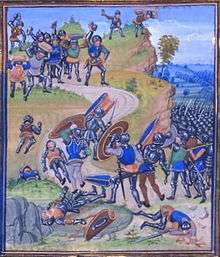Grandes companies

The Grandes companies were mercenary companies recruited between the 12th and 14th centuries by private employers during wars. During peacetime, these mercenaries formed bands called Grandes companies (big companies) and lived by plunder and ransom in the countryside.
Plantagenet era
"Grandes Companies" first appeared in the 12th century, when they participated in the Anarchy (a conflict of succession between King Stephen and the Empress Matilda between 1137 and 1153). They were integrated into the army of King Henry II of England in 1159. In the 1180s, Grandes companies were integrated into the armies of the King of France, under Philip Auguste.
These units were important elements of the armies of Henry II of England, his son Richard I of England, and King John. These troops of seasoned mercenaries were organized and mobile, a valuable advantage during battles of the time. King Philip Augustus of France also hired them to overcome Plantagenêts.
King John used them at the beginning of his reign, when he was richer and more powerful than the King of France. However, in 1204, he did not pay the mercenaries.
The Grandes companies lead the free world to hell in the 14th century, under the reigns of John II and Charles V.
In 1356, men at arms, companies and brigands spread throughout the country between the Seine and the Loire, committing various excesses. They had especially infested the roads from Paris to Orleans, Chartres, Vendôme, and Montargis.
Brigands
Brigands were recruited from all nations.
One of the main leaders was a Welshman named Ruffin, who was enriched by robberies and become a knight. These companies occupied and ransomed towns such as Saint-Arnoult, Gallardon, Bonneval, Cloyes, Étampes, Châtres, Montlhéry, Pithiviers-en-Gatinais, Larchant, Milly-la-Forêt, Château-LandonMandontargis.
Meanwhile, Robert Knolles headed an Anglo-Navarre band of brigands near the borders of Normandy, where he earned 100,000 écus

In October 24, 1360, Edward III and Nicolas Tamworth evacuated the fortresses of Champagne. Irritated by their depredations, the peasants defeated and dispersed several of them. The king sent his constable to take these companies to Spain and rid the kingdom of France of them.
However, after placing Henry of Trastamara on the throne of Castile, the companies returned to France. One company plundered Vire in 1368[1] and another, conducted by John Cresswell and Folquin Lallemant, seized Château-Gontier.
The Tard-Venus were mercenaries who demobilized after the Treaty of Brétigny of 8 May 1360. Under the orders of Seguin de Badefol, they raged from Burgundy to Languedoc. In 1362, in Brignais, they defeated Jacques de Bourbon, Count of La Marche.
The White Company (Compagnia Bianca) was formed after the Treaty of Brétigny of 8 May 1360 and was under the command of John Hawkwood.
The Britons and the English of Dauphiné these companies operated from 1374 to 1411, and accompanied the Counts of Armagnac, Turenne and Duguesclin during conflicts in Provence and Italy, culminating in the Great Schism between the popes of Avignon and Rome. The name derives from the impact of the Dauphine on their provinces during the Hundred Years' War. One of their achievements was taking the Château de Soyons in 1381, until they were dislodged by Bouville, governor of Dauphine and Marshal Clisson. Their leaders were Guilhem Camisard, Amaury de Sévérac (the Bastard of Bertusan) and John Broquiers.
The Écorcheurs were demobilized mercenaries who desolated France in the 15th century after the Treaty of Arras in 1435.
See also
References
- ↑ Yves Buffetaut, « La prise de Vire par les Grandes Compagnies », Itinéraires de Normandie, no 15, septembre 2009, p. 60-64.